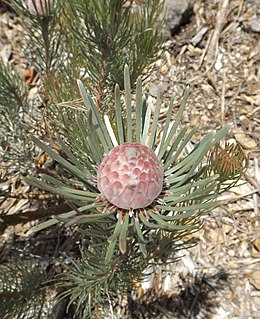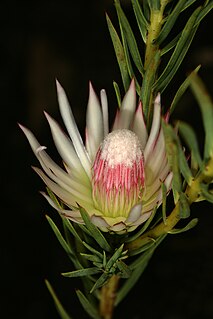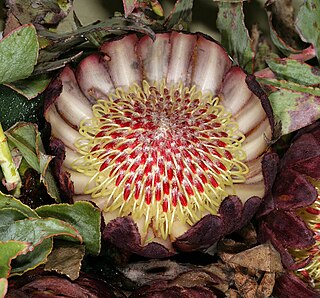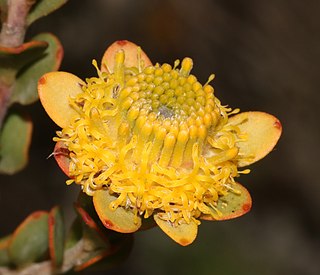
The International Union for Conservation of Nature (IUCN) Red List of Threatened Species, founded in 1964, is the world's most comprehensive inventory of the global conservation status of biological species. It uses a set of precise criteria to evaluate the extinction risk of thousands of species and subspecies. These criteria are relevant to all species and all regions of the world. With its strong scientific base, the IUCN Red List is recognized as the most authoritative guide to the status of biological diversity. A series of Regional Red Lists are produced by countries or organizations, which assess the risk of extinction to species within a political management unit.

Nepenthes kampotiana is a tropical pitcher plant native to southern Cambodia, eastern Thailand, and at least southern coastal Vietnam. It has an altitudinal distribution of 0–600 m above sea level. The specific epithet kampotiana refers to the Cambodian city of Kampot, close to which the first specimens of this species were collected.

Helicia is a genus of 110 species of trees and shrubs, constituting part of the plant family Proteaceae. They grow naturally in rainforests throughout tropical South and Southeast Asia, including India, Sri Lanka, Indochina, Peninsular Malaysia to New Guinea and as far south as New South Wales.
Virotia neurophylla is a species of plant in the family Proteaceae. It is endemic to New Caledonia. It is threatened by habitat loss. It has recently been transferred to the genus Virotia, which is also endemic to New Caledonia.

Protea curvata is a species of plant in the family Proteaceae. It is endemic to South Africa, and a protected tree there.

Serruria florida is a species of flowering plant in the family Proteaceae, endemic to South Africa. It is known by the common names of blushing bride or pride of Franschhoek.

Leucadendron album is a species of flowering plant in the family Proteaceae that grows in South Africa.

Nepenthes palawanensis is a tropical pitcher plant endemic to Sultan Peak on the island of Palawan in the Philippines, where it grows at elevations of 1100–1236 m above sea level. It was discovered in February 2010 by Jehson Cervancia and Stewart McPherson.
Grevillea molyneuxii, commonly known as the Wingello grevillea, is a shrub which is endemic to the shrublands of New South Wales in Australia.

Leucadendron laureolum, common names golden conebush and laurel leaf conebush, is a species of plant in the family Proteaceae. It is endemic to South Africa and also cultivated. It is a large bush that turns bright yellow in the winter flowering season.

Protea aspera, commonly known as rough leaf sugar bush or aardroos suikerbos, is a flowering shrub that belongs to the well-known Protea genus. The plant is endemic to South Africa and is found at Kleinrivierberg, Bredasdorpberg and Garcia's Pass.

Protea subulifolia, the awl-leaf sugarbush, is a flower-bearing shrub belonging to the Protea genus. The plant is native to the Western Cape and occurs from the Stettynskloof to Riviersonderendberge, Langeberg, Bot River to the Elim plain. The plant grows 50 cm in diameter and 70 cm tall and flowers from July to September.

Protea mucronifolia, the dagger-leaf sugarbush, is a flower-bearing shrub belonging to the Protea genus. The plant is endemic to the Western Cape where it occurs from Hermon to Saron. This is the only population. The shrub grows upright and grows 1 m tall and flowers from October to January with the peak from November to December.
Tinadendron is a genus of flowering plants belonging to the family Rubiaceae.

Protea amplexicaulis, the clasping-leaf sugarbush, is a flower-bearing shrub that belongs to the genus Protea. The plant is endemic to South Africa and occurs from Citrusdal to the Kogelberg, as well as in the Langeberg. The shrub remains low and spreads out, becoming 1.3 m in diameter and flowering from June to September.

Leucadendron concavum, the Pakhuis conebush , is a flower-bearing shrub that belongs to the genus Leucadendron and forms part of the fynbos. The plant is native to the Western Cape where it occurs at the Pakhuis Pass in the Cederberg.

Leucadendron coriaceum, the rosette conebush , is a flower-bearing shrub that belongs to the genus Leucadendron and forms part of the fynbos. The plant is native to the Western Cape and occurs from Napier to Riversdale.
Leucadendron cryptocephalum, the concealed conebush, is a flower-bearing shrub that belongs to the genus Leucadendron and forms part of the fynbos. The plant is native to the Western Cape and only two populations occur at Potberg and the Groenlandberg. There is little information available about the plant.

Leucadendron flexuosum, the Worcester conebush, is a flower-bearing shrub belonging to the genus Leucadendron and forms part of the fynbos. The plant is native to the Western Cape, where it occurs in the Breede River Valley near Worcester.
Serruria altiscapa, the stately spiderhead, is a flower-bearing shrub that belongs to the genus Serruria and forms part of the fynbos. The plant is native to the Western Cape and occurs at Blokkop in Villiersdorp as far as the Hottentots-Holland Mountains.















